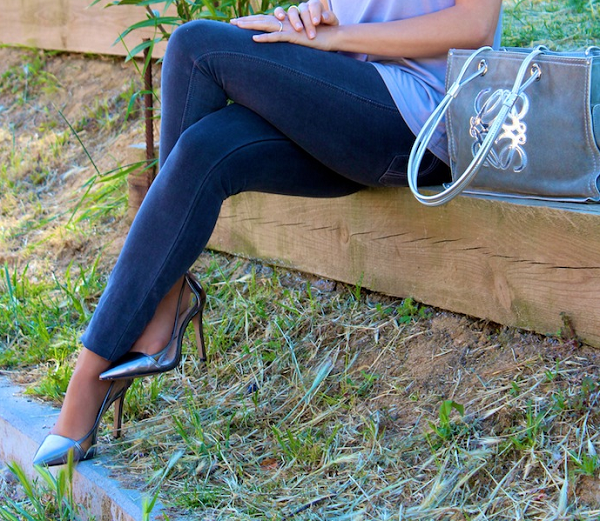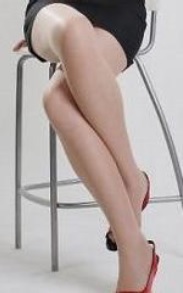Legs are far from our eyes and hence, there are high chances that they get ignored by us during our conversations. However, they do convey a lot of information about our emotions and feelings all the time.
The movement of hands and head certainly contributes to the art of positive body language. However, legs do have their own importance and must be maintained in proper positions. Let’s take a look at what different types of leg crosses imply.
The standing leg cross symbolizes denial to access to the genitals. This is the reason why this posture is considered to be defensive in nature. Hence, such a gesture shows that the person is not confident of oneself, or in other words, lacks self-confidence.

For women, it shows that she wants to stay in the conversation but access to her is denied. In the case of men, it again signifies that the man wants to stay in the conversation but he also wants to ensure that he is not open to everybody’s access.
Hence, the next time, even if someone looks to be friendly in conversation and having relaxed facial expressions along with proper hand movements, but crossed leg position, please note that the person is not as confident or relaxed as he or she is trying to appear.
Always remember the following mantra −


Such type of body language is usually seen with people who are being charged for some crime or being produced in a court for hearing. This is one posture that should be avoided as well.


Tapping of foot is also a big problem with many people that needs to be worked on. The habit of repeated foot tapping on the floor is symbolic of anxiety and impatience. When people wait to receive exam results or medical reports or anything that has a lot of uncertainty associated with it, they begin to tap their foot repeatedly.
For job interviews or group discussions, the legs must be uncrossed and parallel and the feet must be placed firmly on the ground. Women can cross their legs in the form of European leg cross, when they are in group discussions but it is a big ‘No’ for men to do so. Placement of legs and feet play a pivotal role in conveyance of messages of the mind and in getting selected at job interviews and group discussions.
The movement of hands and head certainly contributes to the art of positive body language. However, legs do have their own importance and must be maintained in proper positions. Let’s take a look at what different types of leg crosses imply.
The Standing Leg Cross
The standing leg cross is a body gesture of defiance, defensiveness and submission. This is the posture that is mostly adopted by people when they meet others who are complete strangers.The standing leg cross symbolizes denial to access to the genitals. This is the reason why this posture is considered to be defensive in nature. Hence, such a gesture shows that the person is not confident of oneself, or in other words, lacks self-confidence.

For women, it shows that she wants to stay in the conversation but access to her is denied. In the case of men, it again signifies that the man wants to stay in the conversation but he also wants to ensure that he is not open to everybody’s access.
Hence, the next time, even if someone looks to be friendly in conversation and having relaxed facial expressions along with proper hand movements, but crossed leg position, please note that the person is not as confident or relaxed as he or she is trying to appear.
Always remember the following mantra −
- Open legs − Confidence
- Closed or crossed legs − Reticence
The Double Cross
The double cross happens when the person concerned crosses both the legs and arms. This shows that the person is totally uninterested in speaking to you. Such people are not receptive to communication and hence, it is better either to create a quick rapport with them or leave.
Figure Four Leg Clamp
In this posture, the person locks his one leg over the other and places both his hands on to the raised leg. This gesture shows that the person is totally disinterested in us and is stubborn in attitude. This gesture also signifies that the person is tough minded and does not respect others’ opinion. He is just concerned about his own opinions.
The Ankle Lock
In this posture, the person locks the ankles together. The palms may be clenched in a fist or may be placed on the legs or may be even clutching a chair. This gesture shows that the person is hiding some negative emotion, like anxiety or fear or doubt.Such type of body language is usually seen with people who are being charged for some crime or being produced in a court for hearing. This is one posture that should be avoided as well.
The Leg Twine
In this posture, one of the legs is raised and is locked around the other leg. This is a gesture of shyness and timidity. This one gesture is exclusive to women and is symbolic of insecurity.
Parallel Legs
This is one leg posture that should be adopted by women. It is hardly ever seen being reproduced by any male. This posture gives women a healthier and more attractive look and projects a powerful signal of feminity. This leg posture accounts for a positive body language, confidence and attractiveness and is considered to be the best leg posture for women. It also gives a youthful look to the ladies.
Dominant Stand
This is one posture that is commonly seen with men and women in the military. In this position, the person spreads the legs apart and the feet is placed firmly on the ground. This is a posture of dominance. This posture may look good and dignified in the armed forces, but sometimes it can also look intimidating to other people, because the person taking a dominant stand may appear to be authoritative.Attention Position
This posture is generally suited for situations when a person who is junior in rank is meeting a person senior in rank. This posture conveys no commitment to stay or leave. This posture, therefore, shows that the person is neutral towards the situation and that they have no closed or negative opinions.Sitting Gracefully Is a Woman's Charm
While it seems fine to go with anything you feel comfortable with sitting, nothing beats proper etiquette. Genuine poise comes from within and it's not something that can be taught very well just through words.
The "rules" on how to sit gracefully are simply guidelines and need not be that ironclad to make it fun and rewarding. Some women have an innate grace that just works no matter what they do. Sitting gracefully is behaving with a touch of class and it's the lady-like elegance that's just being the best that you can be.
The "rules" on how to sit gracefully are simply guidelines and need not be that ironclad to make it fun and rewarding. Some women have an innate grace that just works no matter what they do. Sitting gracefully is behaving with a touch of class and it's the lady-like elegance that's just being the best that you can be.
Basic Do’s and Don’ts
Care must also be taken while sitting. Many people sit by turning the chair around and sitting on it by placing the chest on the chair’s frame. This is done mainly to show that the person is occupying space and is trying to be assertive, yet it gives away an altogether opposite message. This posture shows that the person is not confident and is trying to protect himself or herself by creating a barrier between him or her and the other person.Tapping of foot is also a big problem with many people that needs to be worked on. The habit of repeated foot tapping on the floor is symbolic of anxiety and impatience. When people wait to receive exam results or medical reports or anything that has a lot of uncertainty associated with it, they begin to tap their foot repeatedly.
For job interviews or group discussions, the legs must be uncrossed and parallel and the feet must be placed firmly on the ground. Women can cross their legs in the form of European leg cross, when they are in group discussions but it is a big ‘No’ for men to do so. Placement of legs and feet play a pivotal role in conveyance of messages of the mind and in getting selected at job interviews and group discussions.
No comments:
Post a Comment